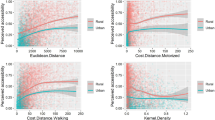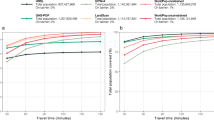Abstract
This research explores local variation in accessibility to primary health care and relationships between travel time and New Zealand deprivation index in the rural Otago. The global relationship between travel time and NZDep2001 index was significantly negative with a t value of −6.11. Suggesting that in general, areas with high travel time to PHC services have lower NZ Deprivation scores than areas with low travel time. Furthermore, there was a great deal of spatial variation in travel time and deprivation index which is not explained by the global regression framework. Geographically Weighted Regression (GWR) analysis was undertaken using an adaptively defined kernel with a bi-square function. The kernel bandwidth was determined by minimisation of the Akaike Information Criterion (AIC) value. The GWR outputs showed that some areas with high travel time were also areas of high NZ deprivation score. Therefore, the GWR results highlighted ‘hot spot’ areas in terms of poor accessibility to PHC facilities in rural Otago, New Zealand.






Similar content being viewed by others
References
Aday, L., & Anderson, R. (1981). Equity of access to medical care: a conceptual and empirical overview. Medical Care, 19(12), 4–27.
Bagheri, N., Benwell, G., & Holt, A. (2006a). Primary health care accessibility for Rural Otago: “A Spatial Analysis”. Primary care & beyond: Building the e-Bridge to integrated care, Auckland, New Zealand, Health Informatics New Zealand (HINZ): 13.
Bagheri, N., Benwell, G. L., & Holt, A. (2006b). Primary health care accessibility for Rural Otago: “A Spatial Analysis”. Health Care and Informatics Review OnlineTM, Retrieved September 3, 2006, from http://hcro.enigma.co.nz/website/index.cfm?fuseaction=articledisplay&FeatureID=010906.
Beere, P., & Brabyn, L. (2006). Providing the evidence: Geographic accessibility of maternity units in New Zealand. New Zealand Geographer, 62, 135.
Blakely, T., & Pearce, N. (2002). Socio-economic position is more than just NZDep. New Zealand Medical Journal, 115, 109–111.
Brabyn, L., & Barnett, R. (2004). Population need and geographical access to general practitioners in rural New Zealand. New Zealand Medical Journal, 117(1199), 1–13.
Brabyn, L., & Gower, P. (2004). Comparing three GIS techniques for modelling geographical access to general practitioners. Cartographica, 39(2), 41–50.
Brabyn, L., & Skelly, C. (2002). Modeling population access to New Zealand public hospitals. International Journal of Health Geographics, 1(3), 6.
Brunsdon, C., Aitkin, M., Fotheringham, A. S., & Charlton, M. (1999). A comparison of random coefficient modelling and geographically weighted regression for spatially non-stationary regression problems. Geographical and Environmental Modelling, 3(1), 47–62.
Crampton, P., Salmond, C., & Sutton, F. (1997a). NZDep91: A new index of deprivation. Social Policy Journal of New Zealand, 9, 186–193.
Crampton, P., Salmond, C., & Sutton, F. (1997b). Research report No 5: NZDep91 index of deprivation. Wellington: Health Services Research Centre.
Davie, G. S., Baker, M. G., Hales, S., & Carlin, J. B. (2007). Trends and determinants of excess winter mortality in New Zealand: 1980 to 2000. BMC Public Health, 7, 263.
Dutt, A. K., Dutt, H. M., Jaiswal, J., & Monroe, C. (1986). Assessment of service adequacy of primary health care physician in a two county region of Ohio, U.S.A. GeoJournal, 12, 443–455.
Fortney, J., Rost, K., & Warren, J. (2000). Comparing alternative methods of measuring geographic access to health services. Health Services and Outcomes Research Methodology, 1(2), 173–184.
Fotheringham, A. S., Brunsdon, C., & Charlton, M. (2002). Geographically weighted regression: The analysis of spatially varying relationships. Chichester: Wiley.
Fotheringham, A. S., & Charlton, M. (1998). Geographically weighted regression: A natural evolution of the expansion method for spatial data analysis. Environment and Planning A, 30, 1905–1927.
Fotheringham, A. S., Charlton, M., & Brunsdon, C. (2001). Spatial variations in school performance: A local analysis using geographically weighted regression. Geographical & Environmental Modelling, 5(1), 43–66.
Guagliardo, M. K. (2004). Spatial accessibility of primary care: concepts, methods and challenges. International Journal of Health Geographics, Retrieved March 3, 2005, from http://www.pubmedcentral.gov/picrender.fcgi?artid=394340&blobtype=pdf.
Hall, B., & Bowerman, R. (2000). AccessPlan: Decision support tool for health care planning. from http://www.fes.uwaterloo.ca/tools/accplan.html.
Hart, J. T. (1971). The inverse care law. Lancet, 1(7696), 405–412.
Higgs, G. (2005). A literature review of the use of GIS-based measures of access to health care services. Health Services and Outcomes Research Methodology, 5(2), 119–139.
Joseph, A. E., & Bantock, P. R. (1982). Measuring potential physical accessibility to general practitioners in rural areas: A method and case study. Social Science and Medicine, 16(1), 85–90.
Joseph, A. E., & Phillips, D. R. (1984). Accessibility and utilisation: Geographical perspectives on health care delivery. London: Haper & Row.
Khan, A. A. (1992). An integrated approach to measuring potential spatial access to health care. Socioeconomic Planning Sciences, 26(4), 275–287.
Knapp, K., & Harwick, K. (2000). The availability and distribution of dentists in rural ZIP codes and primary care health professional shortage areas (PC-HPSA) ZIP codes: Comparison with primary care providers. Journal of Public Health Dentistry, 60(1), 43–48.
Knox, P. (1978). The intraurban ecology of primary medical care: Patterns of accessibility and their policy implications. Environment and Planning A, 10(4), 415–435.
Kwan, M-P., Janelle, D. G., & Goodchild, M. F. (2003). Accessibility in space and time: A theme in spatially integrated social science. Journal of Geographical Systems, 5(1), 1–3.
Lovett, A., Haynes, R., Sunnenberg, G., & Gale, S. (2002). Car travel time and accessibility by bus to general practitioner services: a study using patient registers and GIS. Social Science and Medicine, 55(1), 97–111.
Luo, W. (2004). Using a GIS-based floating catchment method to assess areas with shortage of physicians. Health & Place, 10, 1–11.
Luo, W., & Wang, F. (2003). Measures of spatial accessibility to health care in a GIS environment: Synthesis and a case study in Chicago region. Environment and Planning B, 30, 865–884.
McLafferty, S. L. (2003). GIS and health care. Annual Review of Public Health, 24(1), 7–25.
McLafferty, S., & Grady, S. (2004). Prenatal care need and access: A GIS Analysis. Journal of Medical Systems, 28(3), 321–333.
New Zealand Ministry of Health (2001a). The primary health care strategy. Retrieved July 12, 2005, from http//www.moh.govt.nz.
New Zealand Ministry of Health (2001b). Primary health organisation agreement. Retrieved April 10, 2005, from http://www.moh.govt.nz/pho.
Paez, A., Uchida, T., & Miyamoto, K. (2002a). A general framework for estimation and inference of geographically weighted regression models: 1. Location-specific kernel bandwidths and a test for locational heterogeneity. Environment and Planning A, 34(4), 733–754.
Paez, A., Uchida, T., & Miyamoto, K. (2002b). A general framework for estimation and inference of geographically weighted regression models: 2. Spatial association and model specification tests. Environment and Planning A, 34(5), 883–904.
Pearce, J., Witten, K., & Bartie, P. (2006). Neighbourhoods and health: A GIS approach to measuring community resource accessibility. Journal of Epidemiology & Community Health, 60(5), 389–395.
Penchansky, R., & Thomas, J. W. (1981). The concept of access: Definition and relationship to consumer satisfaction. Medical Care, 19(2), 127–140.
Salmond, C., & Crampton, P. (2002). NZDep2001 Index of Deprivation. from http://www.moh.govt.nz/moh.nsf/Files/phi-research-report/$file/phi-research-report.pdf.
Salmond, C., Crampton, P., King, P., & Waldegrave, C. (2006). NZiDep: A New Zealand index of socioeconomic deprivation for individuals. Social Science and Medicine, 62(6), 1474–1485.
Slack, A., Cumming, J., Mare, D., & Timmins, J. (2002). Variations in secondary care utilisation and geographic access: Initial Analysis of 1996 Data. The 14th Annual Colloquium of the Spatial Information Research Centre, Dunedin, New Zealand, University of Otago: 105–114.
Statistics New Zealand (2005). Defining Urban and Rural New Zealand. Retrieved August 5, 2005, from http://www.stats.govt.nz/urban-rural-profiles/defining-urban-rural-nz/default.htm.
Susi, L., & Mascarenhas, A. K. (2002). Using a geographical information system to map the distribution of dentists in Ohio. Journal of the American Dental Association, 133(5), 636–642.
Wang, F., & Luo, W. (2004). Assessing spatial and non spatial factors for healthcare access: towards an integrated approach to defining health professional shortage areas. Health and Place, 11(2), 62–63.
WHO & UNICEF (1978). Declaration of Alma-Ata. International conference on primary health care, Alma-Ata. Retrieved Dec 20, 2005, from http://www.who.int/chronic_conditions/primary_health_care/en/almaata_declaration.pdf.
Yang, D. H., George, R., & Mullner, R. (2006). Comparing GIS-based methods of measuring spatial accessibility to health services. Journal of Medical Systems, 30(1), 23–32.
Author information
Authors and Affiliations
Corresponding author
Rights and permissions
About this article
Cite this article
Bagheri, N., Holt, A. & Benwell, G.L. Using Geographically Weighted Regression to Validate Approaches for Modelling Accessibility to Primary Health Care. Appl. Spatial Analysis 2, 177–194 (2009). https://doi.org/10.1007/s12061-009-9021-0
Received:
Accepted:
Published:
Issue Date:
DOI: https://doi.org/10.1007/s12061-009-9021-0




